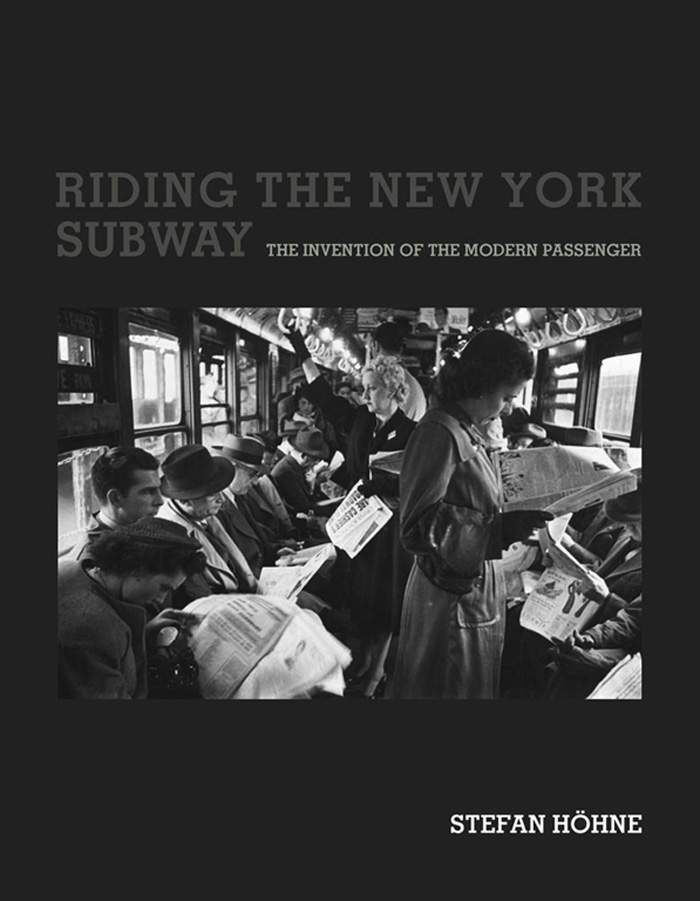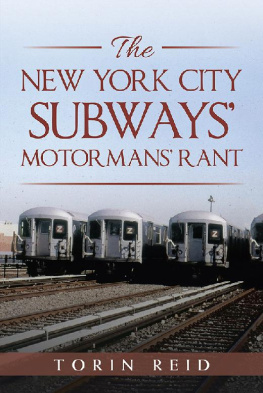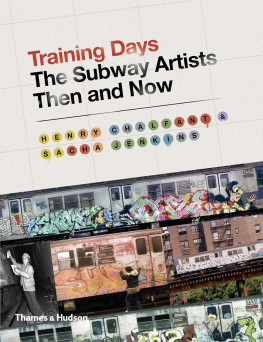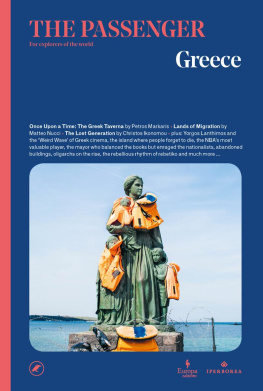Stefan Hohne - Riding the New York Subway: The Invention of the Modern Passenger
Here you can read online Stefan Hohne - Riding the New York Subway: The Invention of the Modern Passenger full text of the book (entire story) in english for free. Download pdf and epub, get meaning, cover and reviews about this ebook. year: 2021, publisher: MIT Press, genre: Politics. Description of the work, (preface) as well as reviews are available. Best literature library LitArk.com created for fans of good reading and offers a wide selection of genres:
Romance novel
Science fiction
Adventure
Detective
Science
History
Home and family
Prose
Art
Politics
Computer
Non-fiction
Religion
Business
Children
Humor
Choose a favorite category and find really read worthwhile books. Enjoy immersion in the world of imagination, feel the emotions of the characters or learn something new for yourself, make an fascinating discovery.

- Book:Riding the New York Subway: The Invention of the Modern Passenger
- Author:
- Publisher:MIT Press
- Genre:
- Year:2021
- Rating:3 / 5
- Favourites:Add to favourites
- Your mark:
- 60
- 1
- 2
- 3
- 4
- 5
Riding the New York Subway: The Invention of the Modern Passenger: summary, description and annotation
We offer to read an annotation, description, summary or preface (depends on what the author of the book "Riding the New York Subway: The Invention of the Modern Passenger" wrote himself). If you haven't found the necessary information about the book — write in the comments, we will try to find it.
Stefan Hohne: author's other books
Who wrote Riding the New York Subway: The Invention of the Modern Passenger? Find out the surname, the name of the author of the book and a list of all author's works by series.
Riding the New York Subway: The Invention of the Modern Passenger — read online for free the complete book (whole text) full work
Below is the text of the book, divided by pages. System saving the place of the last page read, allows you to conveniently read the book "Riding the New York Subway: The Invention of the Modern Passenger" online for free, without having to search again every time where you left off. Put a bookmark, and you can go to the page where you finished reading at any time.
Font size:
Interval:
Bookmark:

Infrastructures Series
edited by Geoffrey C. Bowker and Paul N. Edwards
Paul N. Edwards, A Vast Machine: Computer Models, Climate Data, and the Politics of Global Warming
Lawrence M. Busch, Standards: Recipes for Reality
Lisa Gitelman, ed., Raw Data Is an Oxymoron
Finn Brunton, Spam: A Shadow History of the Internet
Nil Disco and Eda Kranakis, eds., Cosmopolitan Commons: Sharing Resources and Risks across Borders
Casper Bruun Jensen and Brit Ross Winthereik, Monitoring Movements in Development Aid: Recursive Partnerships and Infrastructures
James Leach and Lee Wilson, eds., Subversion, Conversion, Development: Cross-Cultural Knowledge Exchange and the Politics of Design
Olga Kuchinskaya, The Politics of Invisibility: Public Knowledge about Radiation Health Effects after Chernobyl
Ashley Carse, Beyond the Big Ditch: Politics, Ecology, and Infrastructure at the Panama Canal
Alexander Klose, translated by Charles Marcrum II, The Container Principle: How a Box Changes the Way We Think
Eric T. Meyer and Ralph Schroeder, Knowledge Machines: Digital Transformations of the Sciences and Humanities
Geoffrey C. Bowker, Stefan Timmermans, Adele E. Clarke, and Ellen Balka, eds., Boundary Objects and Beyond: Working with Leigh Star
Clifford Siskin, System: The Shaping of Modern Knowledge
Lawrence Busch, Knowledge for Sale: The Neoliberal Takeover of Higher Education
Bill Maurer and Lana Swartz, Paid: Tales of Dongles, Checks, and Other Money Stuff
Katayoun Shafiee, Machineries of Oil: An Infrastructural History of BP in Iran
Megan Finn, Documenting Aftermath: Information Infrastructures in the Wake of Disasters
Ann M. Pendleton-Jullian and John Seely Brown, Design Unbound: Designing for Emergence in a White Water World, Volume 1: Designing for Emergence
Ann M. Pendleton-Jullian and John Seely Brown, Design Unbound: Designing for Emergence in a White Water World, Volume 2: Ecologies of Change
Jordan Frith, A Billion Little Pieces: RFID and Infrastructures of Identification
Morgan G. Ames, The Charisma Machine: The Life, Death, and Legacy of One Laptop per Child
Ryan Ellis, Letters, Power Lines, and Other Dangerous Things: The Politics of Infrastructure Security
Mario Biagioli and Alexandra Lippman, eds, Gaming the Metrics: Misconduct and Manipulation in Academic Research
Malcolm McCullough, Downtime on the Microgrid: Architecture, Electricity, and Smart City Islands
Emmanuel Didier, translated by Priya Vari Sen, America by the Numbers: Quantification, Democracy, and the Birth of National Statistics
Andrs Luque-Ayala and Simon Marvin, Urban Operating Systems; Producing the Computational City
Michael Truscello, Infrastructural Brutalism: Art and the Necropolitics of Infrastructure
Christopher R. Henke and Benjamin Sims, Repairing Infrastructures: The Maintenance of Materiality and Power
Stefan Hhne, Riding the New York Subway: The Invention of the Modern Passenger
Timothy Moss, Conduits of Berlin: Remaking the City through Infrastructure, 19202020
S tefan H hne
T he MIT P ress
C ambridge , M assachusetts
L ondon , E ngland
This translation 2021 Massachusetts Institute of Technology
Originally published as New York City Subway: Die Erfindung des urbanen Passagiers, by Bhlau Verlag: 2017 Bhlau Verlag, GmbH & Cie, Kln Weimar Wien Ursulaplatz 1, D-50668 Kln, www.boehlau-verlag.com
The translation of the this work was funded by Geisteswissenschaften International Translation Funding for Work in Humanities and Social Sciences from Germany, a joint initiative of the Fritz Thyssen Foundation, the German Federal Foreign Office, the collecting society VG Wort and the Brsenverein des Deutschen Buchhandels (German Publishers & Booksellers Association).
All rights reserved. No part of this book may be reproduced in any form by any electronic or mechanical means (including photocopying, recording, or information storage and retrieval) without permission in writing from the publisher.
This book was set in Bembo Book MT Pro by New Best-set Typesetters Ltd.
Library of Congress Cataloging-in-Publication Data
Names: Hhne , Stefan, author.
Title: Riding the New York subway : the invention of the modern passenger / Stefan
Hhne .
Other titles: New York City subway. English | Infrastructures series.
Description: Cambridge, Massachusetts : The MIT Press, [2021] | Series: Infrastructures series | Originally published as New York City Subway: Die Erfindung des urbanen Passagiers, by Bhlau Verlag: 2017 Bhlau Verlagtitle page verso. | Includes bibliographical references and index.
Identifiers: LCCN 2020012668 | ISBN 9780262542012 (paperback)
Subjects: LCSH: SubwaysNew York (State)New YorkHistory20th century. | Urban transportationNew York (State)New YorkHistory20th century. | SubwaysSocial aspectsNew York (State)New YorkHistory20th century. | Human-machine systemsNew York (State)New YorkHistory20th century.
Classification: LCC HE4491.N65 H6513 2021 | DDC 388.4/2097471dc23
LC record available at https://lccn.loc.gov/2020012668
10987654321
d_r0
New York, New YorkA hell of a town,
The Bronx is up and the Batterys down.
The People ride in a hole in the ground.
from the musical On the Town (1944)
As I am finalizing the translated manuscript of this book in early May 2020, the New York City subway and its passengers are once again making headlines throughout the United States and beyond. A few months ago, news emerged of a new and highly infectious coronavirus, spreading rapidly through China and Europe and threatening to severely hit the United States. At the time I am writing, New York City has become the nationwide epicenter of the disease known as COVID-19. With hospitals overwhelmed and casualty numbers soaring, one answer as to how the virus spread so rapidly throughout the citys five boroughs was soon at hand. In mid-April, an economist from the Massachusetts Institute of Technology released a headline-grabbing paper, provocatively titled: The Subways Seeded the Massive Coronavirus Epidemic in New York City.
While this paper has been nearly universally criticized for its flawed methodology and for failing to provide any statistical evidence, it did prove how easily the subway and its passengers can be blamed for crisis in New York City. In early May, after ridership dropped by more than 90 percent, the twenty-four-hour system shut down its overnight service for the first time in its 115-year history to disinfect trains and stations. This not only deprived thousands of essential workers and caretakers of their primary means of transit, it also left many homeless passengers without refuge; they were no longer able to use the subway to avoid crowded shelters, which have become potential breeding grounds for the virus.
This is not the first time that the subway system has been accused of being a public health hazard, nor is it the first time that subway passengers have come under suspicion of being unhygienic and infectious. In the years following the subways opening in 1904, newspapers and health officials stoked passengers fears of suffocation due to a supposed lack of fresh air in the tunnels, and warned of severe eye damage from looking out of subway car windows. The uncontrolled spread of dangerous diseases among its riders was an even greater concern. People were warned not to use the subway because it would be brimming with aggressive germs, exposing its passengers to pneumonia or tuberculosis. Politicians and doctors soon declared the allegedly widespread practice of spitting in the subway as a major disseminatorif not the primary transmission vehicleof the TB pandemic. In the following decades, the unsanitary practices of subway passengers were similarly blamed for outbreaks of influenza or polio in the city. This association testifies to the deep stigma surrounding public transit in the US, which relates to the demographics of a ridership composed largely of people from marginalized groups.
Font size:
Interval:
Bookmark:
Similar books «Riding the New York Subway: The Invention of the Modern Passenger»
Look at similar books to Riding the New York Subway: The Invention of the Modern Passenger. We have selected literature similar in name and meaning in the hope of providing readers with more options to find new, interesting, not yet read works.
Discussion, reviews of the book Riding the New York Subway: The Invention of the Modern Passenger and just readers' own opinions. Leave your comments, write what you think about the work, its meaning or the main characters. Specify what exactly you liked and what you didn't like, and why you think so.






